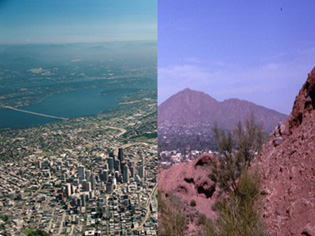 Urban Landscape Patterns: Complex Dynamics and Emergent Properties
Urban Landscape Patterns: Complex Dynamics and Emergent Properties
Investigators: Marina Alberti (PI), John Marzluff, Mark Handcock, Charles Redman, Jianguo Wu, J. Marty Anderies, Dieter Fox, Henry Kautz, & Paul Waddell
Project Description:
Urban development in the United States is profoundly changing landscape pattern and biodiversity and in turn it is being affected by these changes. Yet we are just beginning to understand the interactions between patterns and processes in human dominated landscapes. One of the least understood aspects of urban landscape dynamics is the way in which local interactions of human and biophysical processes affect the landscape patterns of metropolitan regions. Urban landscapes exhibit some fundamental features of complex self-organizing systems. The urban spatial structure can be described as a cumulative and aggregate pattern that results from numerous local decisions involving a large number of adaptive agents interacting among themselves and with biophysical factors. Local behavior of multiple decision-makers eventually can lead to qualitatively and quantitatively different metropolitan patterns. Furthermore, in these complex evolving systems, uncertainty is important since any change that departs from past trends can affect the trajectories of landscape dynamics.
In this project we propose to study urban landscapes as emergent phenomena which result from local interactions of human agents, real estate markets, built infrastructure, and biophysical factors such as land cover, geomorphology, and natural disturbance regimes. Here we define emergent phenomena as structures, patterns and properties in a complex system that are not possessed by any of its parts. Our overarching hypotheses are that: 1) urban landscapes are dynamic patch mosaics that are hierarchically structured resulting from local interactions between human and biophysical agents; 2) spatial interactions between socio-economic and biophysical patterns and processes in the urban landscape lead to emergent properties (e.g. sprawl); and 3) emergent landscape patterns affect biodiversity in non-linear ways (e.g. the intermediate disturbance hypothesis). We intend to formally test hypotheses about the emergent properties of urban landscapes using an agent-based, patch dynamic, hierarchical modeling approach.
We build on ongoing efforts to model land cover change in Seattle (Alberti et al. in review, Marzluff in review) and Phoenix (Berling-Wolff and Wu 2004) to explain complex urban landscape patterns and to develop a theory of urban landscape dynamics. In this project we ask four questions: 1) How do dynamic landscape systems evolve to generate emergent patterns that we see in urban landscapes? 2) What nonlinearities, thresholds, discontinuities, and path dependencies explain divergent trajectories of urban landscapes? 3) How do emergent urban landscape patterns influence biodiversity and ecosystem functioning? and 4) How can the field of planning integrate this knowledge to develop sustainable urban landscape patterns?
We implement this approach using a dynamic probabilistic relational model (DPRM) in which parameters and spatial rules are estimated empirically from two longitudinal land cover and land use data sets developed for the Seattle and Phoenix Metropolitan Areas. We will compare and contrast the results from these different urban areas. While Markov models have been widely used in data mining, they are limited because their definition of state does not allow us to represent multiple state classes that exist in most real-world domains. Mobile robotics and landscape modeling are two different but similar examples of multiple states where first-order Markov models face significant limitations. Here we propose to apply a dynamic probabilistic relational modeling approach to represent a heterogeneous and hierarchically structured domain such as the urban landscape.
Sub-projects:
- Nitrogen modeling in urbanizing ecosystems
- Climate Variability and Patterns of Residential Water Use in the Seattle Region
- Landscape Signatures
- Pricing of environmental quality
- Urbanization impacts on bird populations
- Functions along an urban-to-rural gradient
[project_list page=”1157″]
 Urban Landscape Patterns: Complex Dynamics and Emergent Properties
Urban Landscape Patterns: Complex Dynamics and Emergent Properties